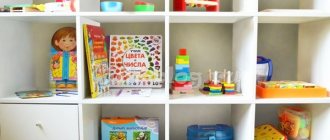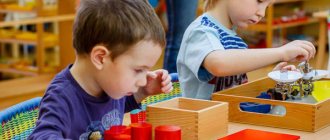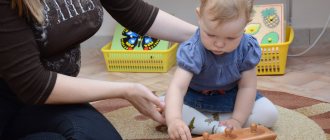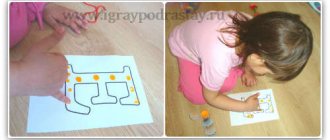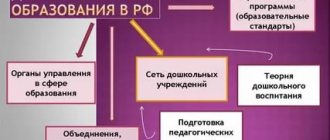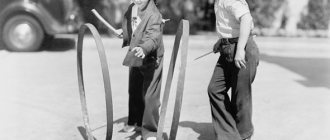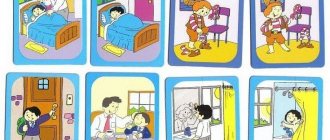According to Maria Montessori's periodization of development, the peak of activity in a variety of directions occurs in children precisely at the age of 2 to 3 years. Kids actively master speech and movement, learn to interact with a variety of objects, learn patterns and become sensitive to order, and also begin to expand their circle of acquaintances and make their first friends.
All this means that it is at this age that it is important to arrange for children all kinds of activities and games for harmonious development.
The motto of the Montessori philosophy is: “Help me do it myself.” The task of adults is to inspire children to make independent discoveries and achievements, because our little ones can do much more than it seems at first glance.
When planning Montessori activities for children 2-3 years old, you should adhere to the following rules:
- Classes should be aimed at increasing the child’s independence,
- Use different senses
- Include elements useful for the development of fine and gross motor skills,
- Take into account the interests of the child and use only at his request,
All Montessori activities should be presented to the child in advance, located in a place accessible to him (on a low shelf) and be accessible without the help of adults (however, exercises with small objects should be offered only when you have time to monitor the baby).
Montessori classes to develop a sense of order for children 2-3 years old
Such exercises help the child understand the principles by which our world exists; mainly here we work on sorting and classification.
Find a pair - Montessori classes for 2-3 years old
The principle of pair selection can be very widely used in working with children:
- Invite your child to sort his own socks and gloves.
- Print out images of animals and offer to compare the picture with existing toy models (the same can be done with your favorite cars, flowers, building models, etc.)
- Offer to find paired cards (colors, images, textures),
- Use special Montessori materials for 2 years and older
Sorting – complicated Montessori games for children from 2 years old
When the baby has mastered pairs, you can move on to a more complex option - sorting.
- Sort cards of different shades by color (you can cut pictures from magazines, scraps, colored cardboard, or you can buy a ready-made Montessori set),
- Remember Cinderella and offer to sort out different types of cereals. First, it is better to take larger grains: beans, chickpeas. Children's breakfast cereals with their cereals, pillows and rings can also be convenient,
- Sort out the box with grandma's buttons by shape, color or number of holes (you definitely have one!)
- Ask your child to put the cutlery in its place,
- Offer to clean up the kitchen and put all the cylinders and balls in one direction, and the cubes and parallelepipeds in the other,
- Rewind the salad: cucumbers to cucumbers, tomatoes to tomatoes, and so on
Establishing Montessori Sequences for a Child 3 Years and Under
- Lay out cards with simple stories and ask your child to remember the correct sequence of events.
- Use Montessori cylinders to help your child master the concepts of less-more and lower-higher,
- Learn simple self-care steps, breaking them down into steps. This way you can learn how to brush your teeth, take a shower, care for animals, and get ready for kindergarten.
Concentration training
UPZ quickly captivates the preschooler, gradually bringing him to a state of concentration, without which work with more complex material in other zones is impossible.
One of the signs of a high level of concentration is the repeated repetition of the same actions in accordance with the goals of the lesson. The next sign is that the child is deeply immersed in the exercise, while the preschooler does not react to what is happening around him. Maria Montessori believed that the process of concentration combines mental and physical energies, shaping the child's personality.
As a result of concentration, children develop a positive emotional state. She leads them to normalization. It is no coincidence that AMI trainers recommend that Montessori teachers give children who come to class for the first time to work in practical life for at least two weeks, and only after that offer materials from sensory, language and mathematics. For the same reason, the practical life zone is always located first - at the entrance to the classroom: this is where the child begins to work and get acquainted with the Montessori environment.
Free lessons from experts
They will help you get acquainted with the basic principles of the Montessori method and apply them in practice.
Montessori classes for the development of fine motor skills for 2-3 years
Little hands still don’t obey as well as adults, but finger coordination is the key to brain development. That is why fine motor skills are given great attention in preschool pedagogy.
Simple lacing is an excellent Montessori activity for children aged 2 years and older.
- Did your parents buy new shoes? First, ask your child to sort out the lacing. Children's shoes may be too small to be familiar with laces, so older ones may help.
- You can purchase a beautiful Montessori set for mastering lacing,
- Make beads or a bracelet from cord and large wooden beads,
- Master weaving craft with your child: weave a rug from large scraps, or maybe you have enough patience for a whole bag,
Pouring water and playing with small objects - Montessori activities that delight children 2-3 years old
- Don't be afraid to encourage children to pour their own water from the jug. Yes, perhaps several glasses will end up on the floor, but after a couple of times the baby will master this task without any problems and will be able to maintain the drinking regime himself (do not forget to offer the child a rag or mop in case water spills),
- Make the most of bath time: children can spend hours fiddling around in the bathtub with molds and toys, and this activity is extremely beneficial for their development,
- Pour small cereal into a bowl, give the child a spoon or scoop and offer to pour it into another container (the width of the neck will determine the difficulty of the whole activity),
- Invite your child to sort small objects (coins, pom-poms, peas, shells or pebbles) using tweezers,
Freedom of choice and formation of will
The possibility of intelligent choice, presented in the zone of practical life, develops the will. The external manifestation of will is freedom of choice and control over one’s movements. If a preschooler has these two properties, then we can talk about the development of his will.
Another indicator is perseverance, which is formed when performing exercises from the educational program. For example, at the initial stage of sewing on cardboard, the child does not always get the needle into the holes, but every time he strains his muscles to control his hand with the needle, the preschooler achieves a positive result - the movements become precise, and the thread lays on the cardboard in beautiful, even stitches.
Introducing literacy and mathematics - interesting Montessori activities for children 3 years old
If your child is already starting to show an interest in letters and numbers, the games presented below can be a great start to learning to read and write.
- Create letter and number bags filled with cereal and other fillings. With the help of these bags you can look for the first letters in words and come up with different games that introduce your child to phonetics,
- Make a couple of sets of cards with letters and numbers and use matching tasks,
- For learning to write, reusable outlines of letters can be useful; they can be traced with finger paints, plasticine and, when the hand is ready, with a pen,
- You can also make images of letters and numbers with a rough surface: this can be done with glue and sand. So the child will quickly remember the outlines of the symbols,
- Sets are great for learning to count, where you can select the required number of objects or dots for each number. This is necessary so that the child understands the meaning of numbers from the very beginning.
Development of the senses through Montessori activities at 2 years and older
- Collect objects of different sizes, shapes and textures in an opaque bag and invite your baby to recognize them by touch.
- Get musical instruments and Montessori sound cylinders: teach your baby to feel the rhythm and pitch of sound, offer to choose pairs, distribute sounds in order,
- An excellent exercise for the development of visual analyzers will be the free work of children with creative materials: gouache, finger paints, watercolors, colored sand, plasticine,
- Sometimes you can find slimes and all kinds of jellies in children's stores; they can also be used to diversify the sensory experience.
Age-appropriate educational materials
The experience of Maria Montessori showed that children are most interested in those activities and objects that are connected with the real life of adults. Therefore, the children's environment should replicate the adult one: let the children's room have dishes, all kinds of jars, boxes, provide the child with everything necessary so that he can pour water, string beads, cut paper, wipe off dust, etc. The Montessori system places great importance on the development of fine motor skills, so don’t forget about playing with beads, buttons, tweezers, clothespins, etc.
I write in detail about what games will be interesting to a child at each stage of development in the sections “Development of fine and gross motor skills” and “Ready lesson programs.”
Montessori games for 2 years old to gain independence at home
These exercises should rather be called a rational organization of space for children, which will help them master all the actions of caring for themselves and their things as quickly as possible:
- Help your child learn to dress independently: you can hang a funny diagram on the wall, you can make stickers on clothes and shoes that will help the child find the right side,
- Place on one tray everything you need to tidy yourself up when you wake up and before bed: comb, toothbrush, toothpaste, glass of water. Let the baby use all these items himself first, and then, if necessary, provide assistance.
- Some particularly stubborn fasteners can be attached to a work surface and create a kind of busy board on which the child can practice skills, so that later buttons and zippers do not cause problems for the child,
- At the same age, it is worth teaching your child to wash his hands with soap correctly; hang a reminder on the door or choose a rhyme that will remind the child to wash his hands after going outside and using the toilet.
According to the Montessori method, children aged 2 years can begin to be assigned general household chores.
- Teach your child how to use a spray bottle and offer to wipe the windows (make sure they are securely closed!) or the mirror. Make sure that your child does not come into contact with aggressive household chemicals,
- At the same age, you can teach your child to wash dishes - first, just rinse plates and cups in water, and then use a sponge,
- Sorting laundry is a great task for children: ask your little one to separate whites from colours, cottons from wool, or simply distribute the laundry into several baskets,
- The baby can start setting the table for himself. To learn the location of cutlery and utensils, you can offer your child a special rug with silhouettes, it will also protect the table from dirt,
- Allow your child to participate in making your home cozy: let him put flowers in a vase, put away pets’ bowls, sweep the floor with his own small broom, arrange photo frames,
- It is useful for the development of gross motor skills to invite the child to lay out the carpet every time he wants to play on the floor, and to roll it up when the game is finished. Make sure that the mat is not too heavy for the child.
Who is not suitable for the Montessori education system?
Parents take their children to Montessori kindergartens and practice this system at home. But is such a desire justified? There are 2 opinions on this matter.
First, the technique is suitable for all children, but not for all parents. For example, authoritarian mothers and fathers will not give the baby much freedom. Did you recognize yourself in history? Reconsider your attitude towards upbringing and interaction with your child: authoritarianism suppresses the little person. It’s easier for you to adjust than for a child.
The second opinion is that the Montessori system is not suitable for all children. And so it is. Consider alternative development options if your child:
- Creative person. Does the child have a developed imagination, does he invent stories, fantasize? He will be bored in class. Try practicing the Montessori method at home: alternate games, combine them, come up with your own variations;
- Uncommunicative. A closed, insecure child can withdraw into himself even more. After all, according to the Montessori method, children study independently, which does not contribute to the development of sociability. And the little introvert will become a beech;
- Restless and restless. Restless, active and restless kids may not fit into the measured, quiet atmosphere of the class. Your fidget will not be able to follow the rule of not disturbing others. Try implementing the Montessori method at home. It will be easier for you to catch the moment when your child is ready to exercise;
- Diagnosed with ASD and autism. Exercise with caution. During classes, isolation and detachment may increase. But practicing the Montessori method at home will be useful: games and exercises require perseverance, which such kids cannot lack;
- Sensitive period missed. Is this your case? Be prepared for the futility of Montessori education. You can try. Pay attention to the personality of the teacher: he should be passive, coordinate the child’s work and not interfere in the process.
conclusions
The Montessori method for children from 2 years old offers a huge selection of activities and allows you to adapt to the interests and character of each child. For the harmonious development of the baby, try to offer your child activities from different blocks, and also make sure that the child always has a choice of what to do.
Any tasks proposed here can be adapted to suit any child. An active fidget can be asked to run around the entire yard in search of objects on cards, and a slow homebody can from time to time make the task easier and bring materials in a basket. A technology lover will find it more interesting to find pairs for cars of different colors, and a wildlife lover will be happy to work on sorting images with animals and plants.
Always make sure your child is satisfied and never force you to complete tasks. Only thanks to internal motivation will the child’s cognitive and emotional development develop successfully.
Socialization
Montessori materials from UPL help children socialize. On the one hand, watering flowers and cleaning the classroom, kids do this for others. On the other hand, they do it for themselves, for example, when combing their hair or getting dressed. But in the second case, they solve the problem of looking neat - in a way that is acceptable in society, that is, they learn to adequately present themselves to others.
Many materials in the UPL area are interconnected, which leads to the establishment of connections between children. For example, there is the exercise “Sewing on a Button”, followed by “Ripping off a Button” (this is the so-called mini-cycle). Recently in one of our classes we observed such a picture. The boy liked to rip off buttons, but really didn’t like sewing them on. Then he agreed with a girl from his classmate that she would sew it on and he would rip it off.

